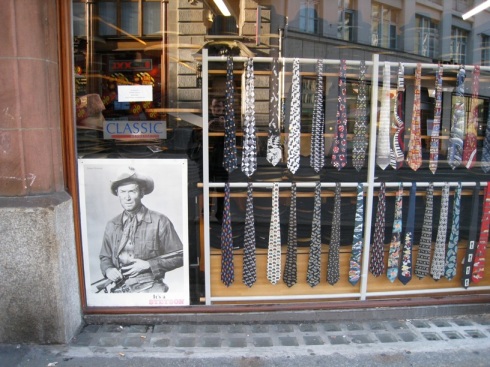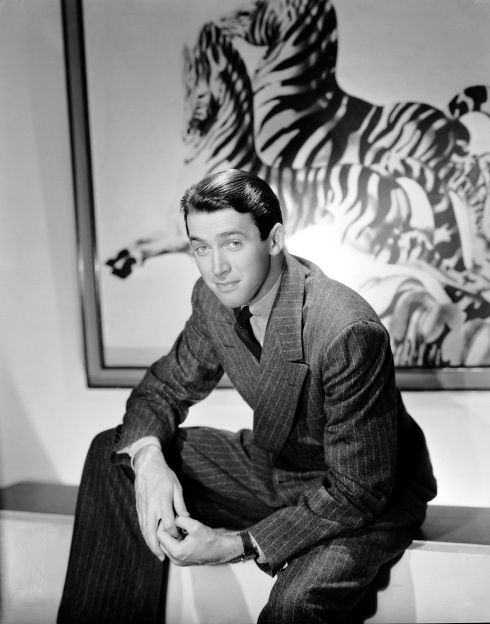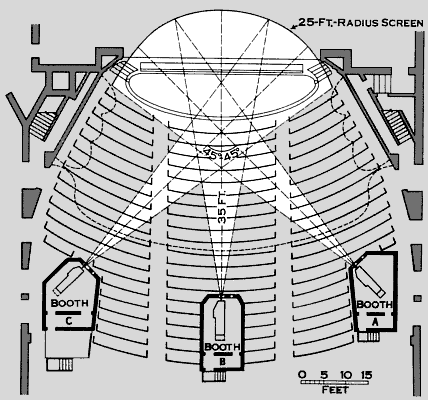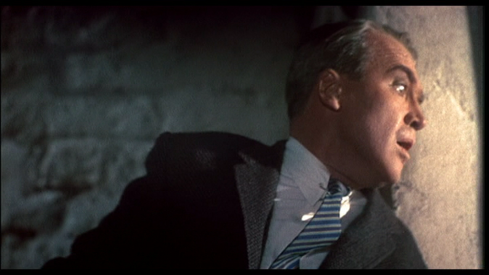You are currently browsing the tag archive for the ‘james stewart’ tag.

Here’s a secret: I watch new movies. I even like some new movies. But truthfully it’s becoming more and more difficult to care about any new releases.
With all the recent Top 10 lists of the films of 2009 and indeed the decade, it was interesting to see how dull a lot of the choices were. Of course there were some great movies over the past 10 years, but I was surprised how many of the choices were movies I didn’t like. There also seemed to be a desperation to pin down the ‘important’ films of the last ten years, but I can’t help feeling that it’s all been done before.
I can’t help thinking that you’d have a far better time watching an old film.
So as an antidote to those lists, here’s my Top 10 of 1939, 70 years prior. It’s almost too easy a selection in this case, as many have commented on how this was perhaps the ‘golden’ year of classical Hollywood.
Could any movie from 2009 beat any of these?
My favourite performer, Jimmy Stewart, in his first western. Dietrich characteristically appears out of place, but wait in particular for the moving ending.
The best kind of epic: spectacular and passionate, yet with a tight focus on its central character. It features both one of the greatest performances and one of the greatest characters of the era, Vivien Leigh as Scarlet O’Hara, a character surely based on Becky Sharp.
I find this movie pretty serious, but it’s atmospheric and exciting, and Cary Grant makes a great adventure hero.
A funny, delicate and complex ensemble drama directed by and featuring Jean Renoir. Worth seeing a few times.
The definitive film about prohibition and the rise of the gangster with Cagney continuing to mark his territory as the performer who revolutionised film acting in the sound era.
The movie that defined James Stewart’s star persona as the naive outsider who brings about law, order and decency. It’s funny and light-hearted in places, but also as political as you want it to be.
The film that galvanised the western genre and created John Wayne’s mighty star image.
The Story of the Late Chrysanthemums
This famous Japanese drama directed by Kenji Mizoguchi is vivid, delicate and moving, with long takes that give it a naturalistic and gentle pace. See this one on the big screen if possible as it’s not currently available on disc.
The film that sums up the Hollywood film experience with its escapist theme and Technicolor technology. See the new Blu Ray transfer if you can, it’s so detailed that it’s practically a new film.
My favourite of these? The Wizard of Oz. The movie I’d watch right now? The Roaring Twenties
.
Surely I haven’t missed any?

George Kennedy alongside James Stewart in Shenandoah (1965)
On Tuesday night (22nd April 2009) I had the great opportunity to attend a live interview with George Kennedy at the BFI Southbank. The conversation was preceded by a screening of Cool Hand Luke in which Kennedy played Dragline, the self-appointed leader of the prison gang who transforms into Luke’s most ardent disciple. His performance of rough masculinity contrasts well with Newman’s cooly confident title character.
I knew Kennedy primarily from his films with James Stewart such as Shenandoah, The Flight of the Pheonix and Fools’ Parade, but of course he has starred in a range of films such as The Sons of Katie Elder with Dean Martin and John Wayne, The Dirty Dozen, Demented with Joan Crawford and the Aiport and Naked Gun series.
When Kennedy took the stage he was gracious and talked engagingly about getting drunk with John Wayne, befriending Bette Davis and even hanging out with Leslie Nielson and O.J. Simpson in their Naked Gun days. I was also interested to find out that he had served in the airforce and went on to act as a technical advisor on Sergeant Bilko where he witnessed the artistry of the vaudevillians at work.
Of particular interest to me was his recollections of knowing James Stewart. To Kennedy, who never knew his father, Stewart became a kind of father figure. Without ever having a male role model in his life, Kennedy believed that Stewart embodied everything a man should be. Interestingly this rings true with our perceptions of Stewart through the virtuous characters he played on-screen. Kennedy had seen Stewart’s films in the 1930s, naming Mr. Smith Goes To Washington, and felt extremely lucky to have worked with and known him. Indeed Kennedy talked of him with reverence and came to hold him in the highest regard of any male in his life. He did not mention the connection between his own wartime service in the airforce (he actually participated in the Battle of the Bulge) and James Stewart’s famously distinguished wartime service.
The evening was a rare opportunity, as would be the next night. It was revealed that Kennedy had flown to London with his old friend and co-star, Ernest Borgnine.
Movie stars are defined by a combination of what we observe of them on-screen and our perception of them outside of the cinema. This would include photographs, articles, interviews, books, posters and merchandise. Film stars and their star images often become far removed from the films themselves. Here are three examples of movie stars as part of the contemporary city. In this case, Charlie selling a shoemaker’s, Jimmy Stewart selling Stetson hats, and John Wayne’s name selling a six-shooter.
If you have any other examples of how classical movie stars have found their way into your city, please send them to me for posting at classicfilmshow@gmail.com
All photos by Christian Hayes.



Today is a big day, the centenary of James Stewart – 100 years since his birth on 20 May 1908. In many ways he is a difficult star to define. Known for his ‘everyman’ persona he also proved to be an actor of unusual intensity. Witness the desperation found in Mr. Smith Goes to Washington (1939), It’s a Wonderful Life (1946), The Naked Spur (1953) and Vertigo (1958).
A particular favourite of mine, I hope to look more closely at James Stewart and his films in upcoming posts as way of celebration.
Seeing as we’ve all seen his Capra and Hitchcock films over and over again, I would suggest watching these five films to celebrate Jimmy:
The Shop Around the Corner (1940)
Winchester ’73 (1950)
The Man From Laramie (1955)
Strategic Air Command (1955)
The FBI Story (1959)
Let me know what you think. Which five would you pick to celebrate the work of James Stewart?
Although Cinemascope was the first of the new widescreen processes to hit the screen with the high-profile The Robe in 1953, a rival technology called Cinerama was premiered in September 1952. By using three adjacent 35mm cameras, an extremely wide image could be created. It actually required five projectionists operating three projectors to view these films. Uniquely the image was projected onto large screens that was literally curved. This would provide the viewers with a spectacular, almost three dimensional, image.
Outside of exotic travelogues intended to exploit the Cinerama experience (much like many IMAX films today), only two fiction films were shot in genuine Cinerama: How the West Was Won (1962) and The Wonderful World of The Brothers Grimm (1962). Later films such as 2001: A Space Odyssey (1968) were filmed in Super Panavision 70 and then presented in a 70mm Cinerama image rather than the 3-Strip image of the original films.
Well now you can view this fascinating process from the comfort of your own home. How the West Was Won, starring John Wayne, Henry Fonda and James Stewart (above), will be released in a new Blu-Ray edition in August. This will include a special feature known as ‘SmileBox’ which will recreate the curved Cinerama image. This seems to be a simple distortion of the image designed to create the illusion of Cinerama, as in this frame from the SmileBox website:
It will be interesting to see how effective this new stab at old technology is, but it sounds like an admirable attempt to present How the West Was Won as it was originally meant to be seen. Until then you can find more information on Cinerama, including some great stills of film frames, at the highly recommended Widescreen Museum.
Below I reprint the review of Vertigo published in the influential British journal Sight and Sound upon its original release in 1958, but first a brief introduction.
Hitchcock in the 1950s
I am very interested in how the reception of films change over time, and how their initial reception relates to their standing today. One of the single most interesting cases is Vertigo (1958), a film that has become embedded in the consciousness of serious filmgoers.
By the time the film was released in 1958 (1959 in Britain) Hitchcock was the most high-profile Hollywood director of them all. No doubt this was galvanised by his appearance on television as host of Alfred Hitchcock Presents (1955-61) in which Hitchcock was cleverly cementing a clearly-defined screen persona – the slow drawl, the black suit, the sense of humour, the portly figure, and the famous profile. It was Hitchcock himself who had transformed his profile into a neat logo, which then went on to open every episode of his TV show. Hitchcock had become an unlikely but powerful brand.
The 1950s saw key changes in how films were written about. Influenced by the politique des auteurs promoted by the French critics of Cahiers du Cinéma, British film critics of Sight and Sound focused more on the role of the director and the director’s responsibility for the film as a whole, then they ever had before. The combination of this shift in film criticism and the strong Hitchcock brand meant that Hitchcock’s role as an auteur was indisputable. In the review below Houston talks of a ‘typical Hitchcock joke’, for instance. Indeed Hitchcock is seen as perhaps the ultimate auteur: the precise visual style of his films suggest to the viewer that he knew what he wanted and achieved it. The controlled movement and pacing of his visuals suggest control behind the camera.
So when Vertigo was released it was clearly seen as another ‘Hitchcock film’. At first glance his films of the 1950s were clearly Hollywood products, as was the case with the glossy star vehicle The Man Who Knew Too Much (1956) with James Stewart and Doris Day, or To Catch a Thief (1955) with Cary Grant and Grace Kelly. He made a couple of grittier movies in the 1950s, notably I Confess (1953) and The Wrong Man (1956), which had the feel of film noir and neo-realism, but Vertigo was clearly aligned with his bigger releases: vivid colour, Vistavision, and a star name in James Stewart. But again Hitchcock seems to smuggle dark themes into these studio movies, with Vertigo being a particularly bleak emotional journey concerned with loss and obsession.
Today the film is revered by critics and film lovers, and during the last Sight & Sound Top Ten Poll in 2002 the film almost beat Citizen Kane to the number one spot – it was only 6 votes away. The fact that Vertigo, along with Rope (1948), Rear Window (1954), The Trouble with Harry (1955), and The Man Who Knew Too Much (1956) were quickly removed from circulation only to be seen again in the 1980s may have contributed to their appeal when re-evaluated (pirate black and white copies circulated for those desperate to see them during that dark age).
Below is the full review that was published in the Spring 1959 issue of Sight and Sound, written by Penelope Houston, which offers an interesting perspective on how the film was received on initial release. She believes that the film suffers from a plot of ‘egg-shell thinness’ and that one of its key problems is that of pacing: ‘this time he is repeating himself in slow motion’. She does not seem to have sensed the repressed passion that drives as an undercurrent throughout the film. This may be due to the fact that Vertigo is ultimately defined by its repeated viewing. The first viewing is only an introduction, but it is in the re-watching that the film starts to take hold and become an obsession.
Please let me know your thoughts on the review and leave a comment.
Penelope Houston, ‘Vertigo’, Sight and Sound, Spring 1959, p.319.
VERTIGO (Paramount) finds Hitchcock toying weightily with a thriller by Pierre Boileau and Thomas Narcejac, authors of Les Diaboliques. As with their earlier novel, the mystery is a question not of who done it but of whether it was really done at all–in this case, how can a girl who has fallen spectacularly to her death from a church tower reappear a few months later in the streets of San Francisco, and is she in fact the same girl? This question of identity, central to the novel, is disposed of by Hitchcock in a brisk and curiously timed flashback, leaving only the secondary problem of how the hero, a detective who first trails the girl, then becomes obsessed by his memories of her, will react to discovering the truth. But in a story of this kind, a sleigh-of-hand affair built on deception and misdirection, mystification counts for everything; to introduce questions of motivation, to suggest that the people involved in this murder game are real, is to risk cracking a plot structure of egg-shell thinness. Only speed, finally, could sustain the illusion that the plot hangs together–and Hitchcock has never made a thriller more stately and deliberate in technique.
If the plot fails to work, there are still some good suspense diversion. These include a macabre, misogynistic sequence in which the obsessed detective (James Stewart) enlists dressmakers and hairdressers to make over the lightly disguised Kim Novak number two in the image of the lost Kim Novak number one; a typical Hitchcock joke, in which the detective tracks the girl down an alley, through a dark and dingy passage-way, and finds that this sinister approach is the back door to an expensive flower shop; and a single shot of stunning virtuosity, with a corpse spread-eagled across a church roof at one side of the screen, and the detective slinking out of the church door at the screen’s opposite edge. A roof-top chase, decisively opening the picture, a struggle in the church belfry, some backchat in the manner of Rear Window with a cool, astringent second-string heroine (Barbara Bel Geddes) are all reminiscent of things Hitchcock has done before, and generally done with more verve. One is agreeably used to Hitchcock repeating his effects, but this time he is repeating himself in slow motion.–PENELOPE HOUSTON










